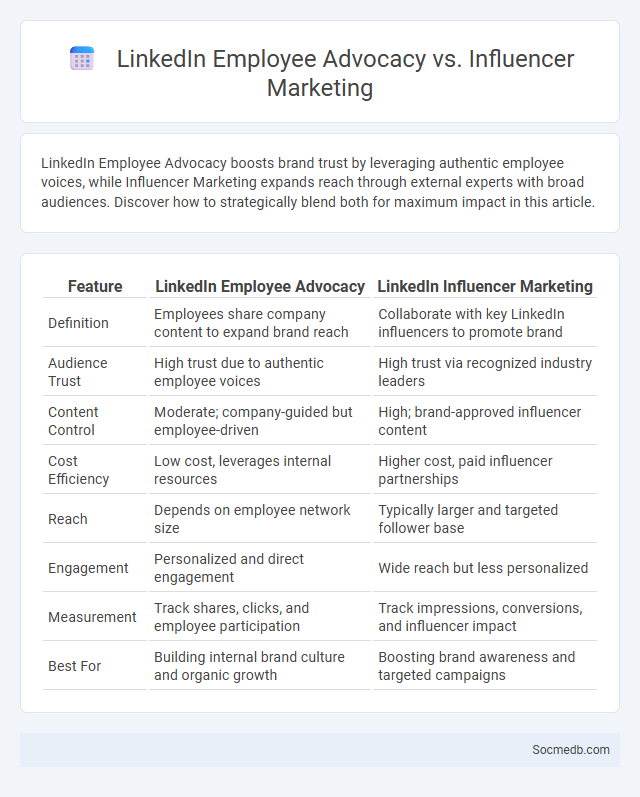
Photo illustration: LinkedIn Employee Advocacy vs Influencer Marketing
LinkedIn Employee Advocacy boosts brand trust by leveraging authentic employee voices, while Influencer Marketing expands reach through external experts with broad audiences. Discover how to strategically blend both for maximum impact in this article.
Table of Comparison
| Feature | LinkedIn Employee Advocacy | LinkedIn Influencer Marketing |
|---|---|---|
| Definition | Employees share company content to expand brand reach | Collaborate with key LinkedIn influencers to promote brand |
| Audience Trust | High trust due to authentic employee voices | High trust via recognized industry leaders |
| Content Control | Moderate; company-guided but employee-driven | High; brand-approved influencer content |
| Cost Efficiency | Low cost, leverages internal resources | Higher cost, paid influencer partnerships |
| Reach | Depends on employee network size | Typically larger and targeted follower base |
| Engagement | Personalized and direct engagement | Wide reach but less personalized |
| Measurement | Track shares, clicks, and employee participation | Track impressions, conversions, and influencer impact |
| Best For | Building internal brand culture and organic growth | Boosting brand awareness and targeted campaigns |
Understanding LinkedIn Employee Advocacy
LinkedIn Employee Advocacy leverages your workforce to promote company content, enhancing brand visibility and credibility through authentic employee voices. Engaging employees as brand ambassadors increases reach by tapping into their professional networks, driving higher engagement and trust compared to traditional marketing. Understanding key metrics like share rates, click-throughs, and employee participation helps optimize your LinkedIn Employee Advocacy strategy for maximum impact.
What Is Influencer Marketing?
Influencer marketing leverages popular social media personalities to promote products or services, capitalizing on their established trust and large follower base. Brands collaborate with influencers on platforms like Instagram, YouTube, and TikTok to create authentic content that drives engagement and boosts conversions. This strategic approach enhances brand visibility and targets niche audiences more effectively than traditional advertising methods.
Employee Advocacy Defined
Employee advocacy is the promotion of a company's brand, products, or services by its employees on their personal social media channels. Your employees share authentic content and positive experiences, amplifying your organization's reach and credibility. Leveraging employee advocacy leads to increased brand awareness, trust, and engagement across social media platforms.
Key Differences: Employee Advocacy vs Influencer Marketing
Employee advocacy leverages authentic promotion by company staff to build brand trust internally and externally, while influencer marketing relies on third-party creators with established audiences to amplify reach. Employee advocates typically have a deeper understanding of company culture and products, fostering genuine engagement, whereas influencers focus on content creation and trend alignment to drive brand visibility. Metrics for employee advocacy emphasize engagement and internal culture impact, contrasting with influencer marketing's focus on reach, impressions, and conversions.
LinkedIn Employee Advocacy: Unique Benefits
LinkedIn employee advocacy enhances brand visibility by leveraging authentic employee voices to share company content, resulting in higher engagement rates and extended reach across professional networks. Employees acting as brand ambassadors increase trust and credibility, which leads to improved lead generation and recruitment efforts. Data shows organizations with active LinkedIn employee advocacy programs experience up to 8 times more engagement and 4 times more traffic compared to traditional brand posts.
Measuring ROI: Advocacy vs Influencer Strategies
Measuring ROI in social media campaigns requires distinct approaches for advocacy and influencer strategies, as brand advocacy relies on genuine customer endorsements while influencer marketing depends on paid partnerships and reach metrics. Advocacy ROI often includes metrics such as customer lifetime value, referral rates, and organic engagement growth, highlighting long-term brand trust and loyalty. Influencer ROI is measured through tracking conversions, engagement rates, and campaign-specific KPIs like cost per acquisition, reflecting immediate impact and audience targeting efficiency.
Building Brand Trust: Employees or Influencers?
Building brand trust on social media hinges on authentic engagement, with employees offering genuine insights and real experiences that foster credibility. Influencers provide extensive reach and creative storytelling but may lack the consistent authenticity that employees bring as everyday brand representatives. Leveraging employee advocacy alongside selective influencer partnerships maximizes trust by combining relatable authenticity with broad audience influence.
Content Strategy Comparison
Effective social media content strategy requires a clear comparison of audience engagement, platform algorithms, and content formats like video, images, and text. Your choice between platforms such as Instagram, LinkedIn, or TikTok should align with your brand goals and target demographics to maximize reach and interaction. Focusing on data-driven insights and consistent content scheduling enhances your social media presence and drives measurable growth.
Challenges and Risks of Each Approach
Social media platforms present diverse challenges and risks depending on the approach; content sharing increases exposure to misinformation and privacy violations, while targeted advertising raises concerns about data security and user manipulation. User-generated content demands rigorous moderation to prevent harassment, hate speech, and harmful behavior, complicating platform governance. Influencer marketing faces authenticity issues and regulatory scrutiny, often risking credibility and legal compliance.
Choosing the Right Strategy for Your Organization
Selecting an effective social media strategy is essential for aligning with your organization's goals and target audience. Analyze platform demographics, content types, and engagement metrics to tailor campaigns that maximize brand visibility and customer interaction. Consistent evaluation and adaptation of the strategy ensure sustained growth and enhanced return on investment.
 socmedb.com
socmedb.com